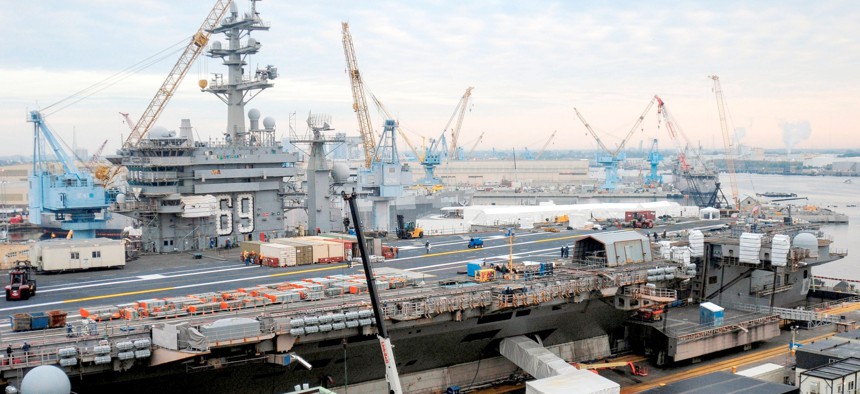
The aircraft carrier USS Dwight D. Eisenhower (CVN 69) sits in dry dock during a 14-month scheduled docking planned incremental availability at Norfolk Naval Shipyard. Mass Communication Specialist Seaman Wesley J. Breedlove
As Navy Pushes for More Ships, Experts Warn Repair Yards Are Crumbling
One congressman suggests contracting ship maintenance work to private yards or even working with allies.
As the U.S. Navy struggles to enlarge its fleet, experts are warning that the service’s four public maintenance yards are ill-equipped to repair even the ships it currently has.
These shipyards in Virginia, Maine, Washington state, and Hawaii don’t have enough workers, drydocks and modern infrastructure and equipment, these experts say.
“[R]egardless of what the future size and composition of the Navy is going to be, the Navy needs to have the support and the maintenance infrastructure to ensure it can maintain that fleet now and in the future,” Diana Maurer, director of the nonpartisan Government Accountability Office’s Defense Capabilities and Management team, said Wednesday at a Heritage Foundation event.
The Navy currently has 296 warships, but has a goal of increasing that number to 355, a number developed before the 2018 National Defense Strategy said the military needs to prepare for competition with China and Russia. Navy leaders are reportedly finalizing plans for an even larger fleer. Defense News reported that the Navy is discussing a fleet size of more than 500 warships.
The Hudson Institute this week recommended a fleet of 581 ships. That total includes 99 unmanned ships and 40 unmanned submarines.
“[M]aintaining ships is just as important as building new ships to reach fleet-size targets, so any spare capacity could also be used to maintain current ships,” Citi analyst Jon Raviv wrote in a note to investors Wednesday.
The Navy plans to invest $21 billion in shipyards over the next two decades to improve dry docks, facilities, and equipment, but that’s not fast enough, according to Rep. Rob Wittman, R-Va, ranking member of the House Armed Services seapower and projection forces subcommittee.
“I think the Navy needs to get much more aggressive about this and shorten that period of time. I don't think that we have 20 years to do these things,” Wittman said during the Heritage Foundation event.
The congressman suggested using more private shipyards for repair work and partnering with allies.
“[I]it can't all just be modernizing the existing public yards or building new new public yards and has to include other elements — partnerships with allies — and making sure that our private yards who have been out of the business of maintaining ships for years, we get them spun back up so they have the capacity and capability to do that as a partner with the Navy,” Wittman said.
GAO has found that the Navy’s public shipyards do not have enough workers and rely on overtime to accomplish tasks, Maurer said.
“That can create in the long run problems and the ability to perform quality work, which is sort of the other other half of the workforce issue,” she said.
Despite hiring some 4,000 new employees at these yards, “they've only been able to grow on net the number of skilled workers and key production professions by 400,” she said.
Then there are poor conditions for these workers.
“The facilities are old, the equipment is old, the number of dry docks currently not sufficient by the Navy's own analysis from a couple of years ago,” Maurer said. “If you look ahead about 20 years, they will be unable to do one third of the planned maintenance periods on submarines and aircraft carriers simply because of a lack of dry dock space. That's a significant problem.”
The Navy’s efforts to improve these four shipyards has been “a little too scattershot,” Maurer said. GAO recommends the service “become more of a data driven organization to obtain the information they need to identify root causes.” Since the yards will take years to fix, it will need the attention of top leaders.
“I think looking into the future, this issue of the Navy's ability to have functioning shipyards, to turn around maintenance in a timely way, is nested within the broader policy debate about the size and composition of the Navy,” Maurer said.




